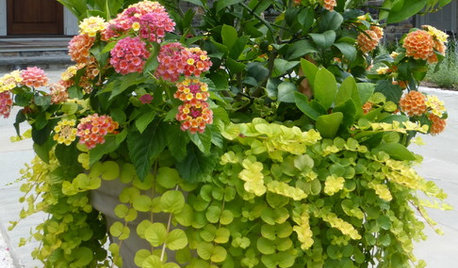Andrew's Wild Tomato / Breeding Wiki
keen101 (5b, Northern, Colorado)
6 years ago
Featured Answer
Comments (40)
keen101 (5b, Northern, Colorado)
6 years agoRelated Discussions
Is cross-breeding even comparable to genetically modified?
Comments (32)"There is no method of cross breeding that can insert bacteria DNA into a vegetable plant like transgenic corn and cotton has" You've clearly never heard of retroviruses, which do exactly that. "GMO crops then are no longer technically corn or soy or sugar beets but mutants" Mutation is the single most important thing in evolution, and the adaptation of life (which is a two part process - mutation expands the genome, natural selection winnows it down to what is useful). It's not a bad thing. Genetic Engineering is also DRASTICALLY more predictable than traditional crossbreeding. You want to pull the genes from a Geneva roostock that code for fireblight resistance and put it in a different apple? Trivial. You want to cross one of the geneva lines with a Braeburn apple and try to get an apple that tastes right and isn't very susceptible to fireblight? Almost impossible. Predictability also leads to safety. You want to try and get a resistance gene from a wild solanum into a tomato? Easy with gene splicing. Via traditional breeding? You're very likely to end up with something that will kill you if you eat it....See MoreFavorite Website Links
Comments (28)I bought seeds last May from Territorial Seed Co and from Baker Creek. That was after my experience with 110 Bhut Jolokia seedlings. I only planted twelve each, of Lemon Drops and of Melrose Pepper. All of them came up and were planted in the garden. Mary...See MoreMy 2008 Tomato Varieties
Comments (41)Here is my list. I already have my seed. I will be starting them mid/late March, and investing in wall-o-water cold protectors so I can set them out a bit early. I may leave out one of the glacier/manitoba/moskovich varieties, but we'll see. Beefsteak Aunt Ruby's German Green * (cutworms got my plant last year) Big Rainbow Black Krim Black Sea Man * Brandywine, Sudduth's Strain Cherokee Purple Kellogg's Breakfast Northern Lights Striped German Sunset's Red Horizon Medium Black Prince Black Zebra * (cutworms got my plant last year) Druzba Earl of Edgecombe * Eva's Purple Ball Flammé Glacier Green Zebra Japanese Black Trifele * Manitoba Moskovich New Girl * Peche Jaune Pink Ping Pong Purple Calabash Shimmeig Striped Hollow Stupice Valencia Cherries Black Cherry Green Grape Principe Borghese Cherry Tomato Sun Gold Washington Cherry * White Cherry * Plum/Paste Andes * Debarao * Opalka * Orange Roma Purple Russian * Russian Big Roma * San Marzano Wonder Light * New to me this year...See MoreTomato Plants popped up from last years rotted fruit
Comments (24)I've got volunteer periwinkles from about three years ago that grew before I turned the spot into a vegetable garden. Every year I see a couple new seedlings pop up. I also have a volunteer dill from last year's seed. It came up in the middle of the beet patch and I'm just letting it grow. My Swamp Milkweed that I planted last year dropped some seeds (I was careful to harvest pods before they burst open, but I still missed a few). I've got lots of milkweed volunteers coming up all over the place. So far, I haven't got a tomato volunteer yet. And on the subject of Santa grape tomatoes - if they still have them at our grocery store, I may have to try saving some seeds and growing them out sometime. Sounds interesting....See MoreMokinu
6 years agolast modified: 6 years agokeen101 (5b, Northern, Colorado)
6 years agokeen101 (5b, Northern, Colorado)
6 years agolast modified: 6 years agokeen101 (5b, Northern, Colorado)
6 years agokeen101 (5b, Northern, Colorado)
6 years agokeen101 (5b, Northern, Colorado)
6 years agokeen101 (5b, Northern, Colorado)
6 years agokeen101 (5b, Northern, Colorado)
6 years agoMokinu
6 years agolast modified: 6 years agoMokinu
6 years agokeen101 (5b, Northern, Colorado)
6 years agoMokinu
6 years agolast modified: 6 years agokeen101 (5b, Northern, Colorado)
6 years agoMokinu
6 years agolast modified: 6 years agoMokinu
6 years agokeen101 (5b, Northern, Colorado)
6 years agokeen101 (5b, Northern, Colorado)
6 years agokeen101 (5b, Northern, Colorado)
6 years agokeen101 (5b, Northern, Colorado)
6 years agoMokinu
6 years agokeen101 (5b, Northern, Colorado)
6 years agokeen101 (5b, Northern, Colorado)
6 years agoMokinu
6 years agolast modified: 6 years agokeen101 (5b, Northern, Colorado)
6 years agolast modified: 6 years agokeen101 (5b, Northern, Colorado)
6 years agoMokinu
6 years agolast modified: 6 years agokeen101 (5b, Northern, Colorado)
6 years agoMokinu
6 years agokeen101 (5b, Northern, Colorado)
6 years agoMokinu
5 years agolast modified: 5 years agokeen101 (5b, Northern, Colorado)
5 years agokeen101 (5b, Northern, Colorado)
5 years agoMokinu
4 years agokeen101 (5b, Northern, Colorado)
4 years agokeen101 (5b, Northern, Colorado)
4 years ago
Related Stories

LANDSCAPE DESIGNNatural Swimming Pools: More Beauty, No Chemicals
Keep your skin and the environment healthy with a pool that cleans itself, naturally
Full Story
FRONT YARD IDEAS10 Ideas for a Front-Yard Edible Garden Your Neighbors Will Love
Choosing attractive, well-mannered plants and sharing the bounty will go a long way toward keeping the peace
Full Story
FUN HOUZZDon’t Be a Stickybeak — and Other Home-Related Lingo From Abroad
Need to hire a contractor or buy a certain piece of furniture in the U.K. or Australia? Keep this guide at hand
Full Story
GARDENING GUIDESBlooming Container Gardens That Welcome Butterflies and Bees
Attract pollinators with one of these colorful nectar- and pollen-rich container combinations
Full Story






Mokinu